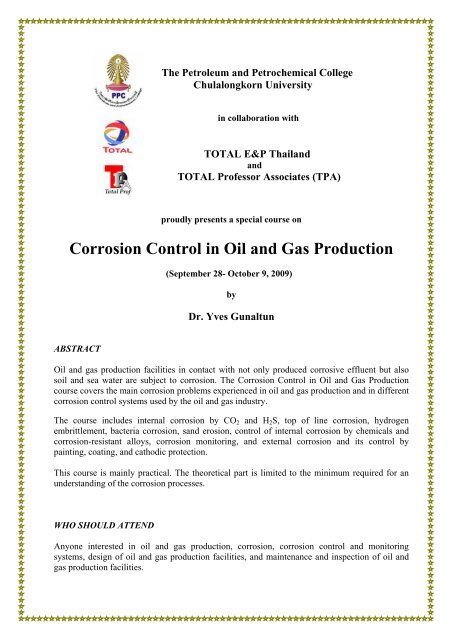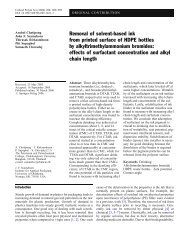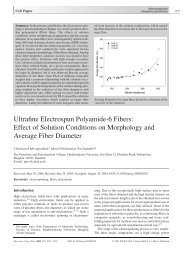Corrosion Control in Oil and Gas Production - The Petroleum and ...
Corrosion Control in Oil and Gas Production - The Petroleum and ...
Corrosion Control in Oil and Gas Production - The Petroleum and ...
You also want an ePaper? Increase the reach of your titles
YUMPU automatically turns print PDFs into web optimized ePapers that Google loves.
<strong>The</strong> <strong>Petroleum</strong> <strong>and</strong> Petrochemical College<br />
Chulalongkorn University<br />
<strong>in</strong> collaboration with<br />
TOTAL E&P Thail<strong>and</strong><br />
<strong>and</strong><br />
TOTAL Professor Associates (TPA)<br />
proudly presents a special course on<br />
<strong>Corrosion</strong> <strong>Control</strong> <strong>in</strong> <strong>Oil</strong> <strong>and</strong> <strong>Gas</strong> <strong>Production</strong><br />
(September 28- October 9, 2009)<br />
by<br />
Dr. Yves Gunaltun<br />
ABSTRACT<br />
<strong>Oil</strong> <strong>and</strong> gas production facilities <strong>in</strong> contact with not only produced corrosive effluent but also<br />
soil <strong>and</strong> sea water are subject to corrosion. <strong>The</strong> <strong>Corrosion</strong> <strong>Control</strong> <strong>in</strong> <strong>Oil</strong> <strong>and</strong> <strong>Gas</strong> <strong>Production</strong><br />
course covers the ma<strong>in</strong> corrosion problems experienced <strong>in</strong> oil <strong>and</strong> gas production <strong>and</strong> <strong>in</strong> different<br />
corrosion control systems used by the oil <strong>and</strong> gas <strong>in</strong>dustry.<br />
<strong>The</strong> course <strong>in</strong>cludes <strong>in</strong>ternal corrosion by CO 2 <strong>and</strong> H 2 S, top of l<strong>in</strong>e corrosion, hydrogen<br />
embrittlement, bacteria corrosion, s<strong>and</strong> erosion, control of <strong>in</strong>ternal corrosion by chemicals <strong>and</strong><br />
corrosion-resistant alloys, corrosion monitor<strong>in</strong>g, <strong>and</strong> external corrosion <strong>and</strong> its control by<br />
pa<strong>in</strong>t<strong>in</strong>g, coat<strong>in</strong>g, <strong>and</strong> cathodic protection.<br />
This course is ma<strong>in</strong>ly practical. <strong>The</strong> theoretical part is limited to the m<strong>in</strong>imum required for an<br />
underst<strong>and</strong><strong>in</strong>g of the corrosion processes.<br />
WHO SHOULD ATTEND<br />
Anyone <strong>in</strong>terested <strong>in</strong> oil <strong>and</strong> gas production, corrosion, corrosion control <strong>and</strong> monitor<strong>in</strong>g<br />
systems, design of oil <strong>and</strong> gas production facilities, <strong>and</strong> ma<strong>in</strong>tenance <strong>and</strong> <strong>in</strong>spection of oil <strong>and</strong><br />
gas production facilities.
COURSE INSTRUCTOR: Dr. Yves Gunaltun<br />
Dr. Yves Gunaltun received his graduate degree <strong>in</strong> Chemical Eng<strong>in</strong>eer<strong>in</strong>g <strong>in</strong> 1977 <strong>and</strong> his Ph.D.<br />
<strong>in</strong> Electrochemistry <strong>and</strong> Analytical Electrochemistry <strong>in</strong> 1981, both <strong>in</strong> France.<br />
He jo<strong>in</strong>ed TOTAL <strong>in</strong> 1982 as a corrosion eng<strong>in</strong>eer. He was seconded to ZADCO (Abu Dhabi -<br />
UAE) from mid 1987 to the end of 1992 as a senior corrosion eng<strong>in</strong>eer. <strong>The</strong>n he was seconded to<br />
Qatargas (Houston - USA) <strong>in</strong> mid 1993 as a material eng<strong>in</strong>eer for the LNG project. From mid<br />
1994 to mid August 2006 he was <strong>in</strong> the technology division of TOTAL EP <strong>in</strong> charge of<br />
development projects <strong>and</strong> technical assistance for Brunei, Indonesia, Thail<strong>and</strong>, Myanmar,<br />
Azerbaijan, Kazakhstan, <strong>and</strong> Russia. He was <strong>in</strong>volved <strong>in</strong> R&D projects at Ohio University <strong>and</strong><br />
IFE (Norway). He gave lectures <strong>in</strong> universities <strong>in</strong> France, USA, Turkey, Thail<strong>and</strong>, <strong>and</strong><br />
Indonesia. His work experience <strong>in</strong>cludes teach<strong>in</strong>g corrosion at different universities <strong>in</strong> France<br />
<strong>and</strong> at petroleum <strong>in</strong>stitutes <strong>in</strong> France, Indonesia, <strong>and</strong> Thail<strong>and</strong>.<br />
Dr. Gunaltun is now hold<strong>in</strong>g the corrosion specialist position at TOTAL. S<strong>in</strong>ce mid August 2006<br />
he is seconded at PTTEP (Bangkok) for two years for 80% of his time. For the rema<strong>in</strong><strong>in</strong>g 20% of<br />
his time he is still <strong>in</strong> charge of TOTAL operations <strong>in</strong> South East Asia <strong>in</strong> the doma<strong>in</strong> of corrosion.<br />
Dr. Gunaltun is a cathodic protection specialist certified NACE level 4 <strong>and</strong> his experience<br />
<strong>in</strong>cludes:<br />
• Vice Chairman of CO 2 <strong>Corrosion</strong> Symposium – NACE 2004,<br />
• Chairman of CO 2 <strong>Corrosion</strong> Symposium – NACE 2005,<br />
• Organizer <strong>and</strong> Chairman of the Special Symposium “CO 2 <strong>and</strong> H 2 S Metal Loss <strong>Corrosion</strong><br />
<strong>in</strong> <strong>Oil</strong> <strong>and</strong> <strong>Gas</strong> <strong>Production</strong>” – NACE 2006,<br />
• Chairman of the work<strong>in</strong>g party for the preparation of “Guidel<strong>in</strong>e for the Prediction of<br />
Internal <strong>Corrosion</strong> Severity”,<br />
• Member of NACE <strong>and</strong> European Federation of <strong>Corrosion</strong>, <strong>and</strong><br />
• Member of TPA (TOTAL Professor Associates),<br />
Dr. Gunaltun has about 50 publications <strong>in</strong> the fields of electrochemistry <strong>and</strong> corrosion.
OUTLINE<br />
Day 1 <strong>and</strong> Day 2<br />
o Introduction to <strong>Oil</strong> <strong>and</strong> <strong>Gas</strong> <strong>Production</strong><br />
o <strong>Corrosion</strong> Mechanism<br />
o Internal Metal Loss <strong>Corrosion</strong>:<br />
• CO 2 <strong>and</strong> H 2 S Metal Loss <strong>Corrosion</strong>, Top of L<strong>in</strong>e <strong>Corrosion</strong><br />
• Galvanic <strong>Corrosion</strong>, Bacteria <strong>Corrosion</strong>, S<strong>and</strong> Erosion<br />
• <strong>Corrosion</strong> <strong>in</strong> Sweeten<strong>in</strong>g <strong>and</strong> Dehydration Units<br />
• <strong>Corrosion</strong> <strong>in</strong> Sea Water Treatment Units<br />
Day 3<br />
o Internal Metal Loss <strong>Corrosion</strong> (cont.):<br />
• Hydrogen Embrittlement, Sulfide Stress Crack<strong>in</strong>g (SSC) <strong>and</strong> Hydrogen Induced<br />
Crack<strong>in</strong>g (HIC)<br />
• Prevention of Hydrogen Embrittlement, SSC, HIC<br />
Day 4 <strong>and</strong> Day 5<br />
o Internal Metal Loss <strong>Corrosion</strong> (cont.):<br />
• <strong>Control</strong> of Metal Loss <strong>Corrosion</strong> (Design, Chemical Treatment, Material Selection, <strong>and</strong><br />
Coat<strong>in</strong>g)<br />
• Monitor<strong>in</strong>g of Internal <strong>Corrosion</strong><br />
Day 6<br />
o External <strong>Corrosion</strong><br />
• Atmospheric <strong>Corrosion</strong><br />
• Sea water <strong>Corrosion</strong><br />
• <strong>Corrosion</strong> <strong>in</strong> Soil<br />
Day 7<br />
o <strong>Control</strong> of External <strong>Corrosion</strong><br />
• Metallic Coat<strong>in</strong>gs<br />
• Pa<strong>in</strong>t<strong>in</strong>g <strong>and</strong> Coat<strong>in</strong>gs<br />
• Pr<strong>in</strong>cipal of Cathodic Protection<br />
Day 8 <strong>and</strong> Day 9<br />
o Protection of Onshore <strong>and</strong> Offshore Facilities by Cathodic Protection<br />
• Sacrificial Anode System<br />
• Impressed Current System<br />
• Cathodic Protection Design<br />
• Monitor<strong>in</strong>g<br />
• Interference Problems<br />
Day 10<br />
o Conclusions, Q&A<br />
o Quiz
DATE AND TIME<br />
<strong>The</strong> course will be held from September 28 through October 9, 2009 (Mon.-Fri. only) from<br />
9:00 a.m. to 12.00 a.m. Check-<strong>in</strong> <strong>and</strong> Registration will take place from 8:00 a.m. on<br />
September 28, 2009. Coffee <strong>and</strong> lounge facilities will be available from 7:30 a.m. each day.<br />
VENUE<br />
Third Floor, <strong>The</strong> <strong>Petroleum</strong> <strong>and</strong> Petrochemical College<br />
REGISTRATION FEE<br />
<strong>The</strong> registration fee is 18,000 baht per person, which covers course materials <strong>and</strong> coffee<br />
breaks. A Certificate of Attendance will be presented to all participants at the end of the<br />
course.<br />
Please send the Application Form, together with the registration fee to:<br />
<strong>The</strong> Office of Academic Service Affairs<br />
<strong>The</strong> <strong>Petroleum</strong> <strong>and</strong> Petrochemical College<br />
Chula Soi 12, Phyathai Road Bangkok 10330, THAILAND<br />
Tel: 0-2218-4155, 0-2218-4154 Fax: 0-22184154<br />
E-mail:ppcshortcourse@chula.ac.th<br />
http:/www.ppc.chula.ac.th/shortcourse<br />
Please pay by<br />
Crossed check “Account Payee Only” under the name of<br />
“<strong>The</strong> <strong>Petroleum</strong> <strong>and</strong> Petrochemical College”<br />
Direct transfer to the Account of “<strong>The</strong> <strong>Petroleum</strong> <strong>and</strong> Petrochemical College CU”<br />
number 1520798974, Bangkok Bank (Siam Square Branch) 393 Rama 1 Road,<br />
Bangkok 10330<br />
Tel: 0-2252-1330-9 Fax: 0-2252-3204<br />
MAP<br />
<strong>The</strong> <strong>Petroleum</strong> <strong>and</strong> Petrochemical<br />
College occupies eight<br />
floors of a 14-story build<strong>in</strong>g<br />
located on Chula Soi 12, Phyathai<br />
Road (next to SASIN Graduate<br />
School). Park<strong>in</strong>g sites are<br />
available next to the Thai House<br />
opposite Sas<strong>in</strong>.





